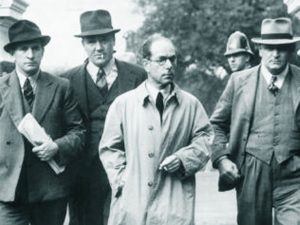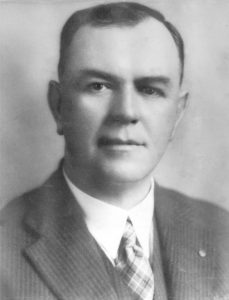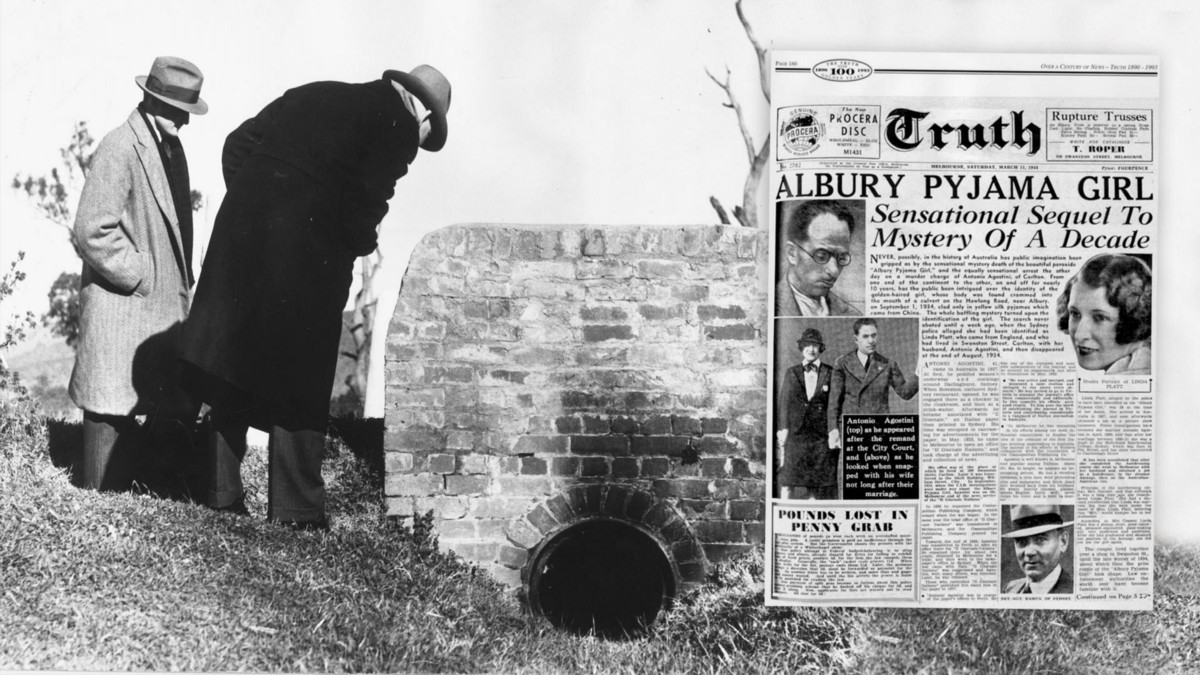The ‘Pyjama Girl’ case was one of Australia’s most sensational murder mysteries, but did the police really ‘get their man’ in the end?
On September 1, 1934, just outside Albury on the New South Wales border with Victoria, a young farmer was walking home with his family’s new prize bull when he made a gruesome discovery — the partially burnt corpse of a young woman with part of her body stuffed into a culvert. Thus began one of Australia’s longest and most sensational murder mysteries. It would be 10 years before the police closed the case.
The medical examiner found that the badly burnt body had been placed in a hessian bag, a towel had been wrapped around her head which had been savagely caved in and only a few scraps of yellow fabric remained of her clothing. Despite finding a small calibre bullet lodged in her throat, he concluded that the terrible injuries to her skull and brain had caused her death. He described her as between the ages of 20 and 30, with a slim build, light brown hair and blueish-grey eyes.
Back at the scene of the discovery, police detected the strong odour of kerosene and a brown, oily substance. A witness had seen a fire there in the early hours of August 29, but there had been heavy rain that night which would have extinguished the flames. The police concluded that the woman had been killed elsewhere, most likely on August 28, and her body dumped and burnt at the site. Whoever had dumped the body must have worked hurriedly because the pipe had been big enough to conceal the whole corpse. Nor could he have known the area well as the culvert, although it could not be seen from a passing car, was under a main road.
The police had no way of identifying the body. Preserved in ice at the Albury morgue, it was viewed by hundreds of people, but no one recognised her. With her face terribly deformed by the injuries to her skull, the photograph the police circulated had to be altered to make her look more lifelike, while the newspapers were only given a sketch.
The metropolitan newspapers soon descended on Albury and before too long the dead woman had been dubbed the ‘Pyjama Girl’ for the fabric remnants which had been identified as the remains of yellow and white silk pyjamas. With nothing else to go on, the reporters built elaborate and totally baseless fantasies around her supposed beauty and innocence or lack thereof, her exotic pyjamas and her fiendish murderer.
The investigation was closely followed by the press, but week after week there was no news to report, while the police followed every possible lead to identify the body. They even went so far as to track down all the women under 40 who had failed to vote in the federal election on the weekend following the discovery (voting is compulsory in Australia), all to no avail. To assist with the investigation, the police preserved the body in formalin in a zinc-lined bath and moved it to the University of Sydney, where, over the following years, it was viewed by hundreds, if not thousands, of people who still could not identify it.
It was not until March 1944 that the police got their man. The Commissioner of the New South Wales police, William McKay, together with most of Sydney’s most powerful people, frequented Romano’s, a fashionable Italian restaurant. He noticed his waiter, Antonio Agostini, whom he remembered from before the war, was looking rather agitated, so he invited him to police headquarters where Agostini confessed to killing his wife in Melbourne ten years earlier.

Antonio Agostini being escorted into court.
Antonio Agostini was an Italian immigrant who had arrived in Australia in 1927. Linda Platt was born in England and had arrived in Australia, via New Zealand, that same year. They married in Sydney in 1930. In his long and detailed statement, Agostini told the police that his wife had had a drinking problem and one reason why they moved to Melbourne in 1933 was to get Linda away from her drinking associates. However, her drinking had continued and she had made Antonio’s life a misery. One Monday morning, he had woken to find her threatening him with a revolver. In the ensuing struggle the gun had gone off and killed Linda. Unable to bear the shame the death would have brought on himself and the Italian community, Agostini had not been able to bring himself to report it to the police. That evening he had put Linda’s body in his car and, taking a spare can of petrol, had gone for a long drive. When he saw the lights of Albury, he turned off the road, stuffed Linda’s body under a small bridge, doused it in petrol and set fire to it.
Agostini voluntarily returned to Melbourne where an inquest was soon convened. Despite the identification being contested by Dr Thomas Benbow, who claimed the body was that of Sydney girl Philomena Morgan, the coroner came to the conclusion that it was indeed the body of Linda Agostini. Agostini was tried for her murder, but was found guilty of manslaughter instead and sentenced to six years with hard labour. He was released in 1948 after serving less than four years and deported to Italy where he lived out his life in Sardinia, dying in 1969.
Well, that’s the official story, but is it the whole story? Not according to Melbourne historian, Richard Evans. In his book The Pyjama Girl Mystery: a true story of murder, obsession and lies, Evans comes to a very different conclusion.
Antonio Agostini’s occupation is usually given as waiter in the official story, but in truth, he had been working as a waiter for only three weeks when he was arrested. While he had leased the cloakroom at Romano’s when he first arrived, he was university educated and spent most of his working life in Australia as a journalist, in Sydney and Melbourne, for Il Giornale Italiano, a newspaper for the Italian immigrant community whose patriotic Fascism Agostini shared. It was because of his journalism that, after the outbreak of the Second World War, Agostini was interned in 1940 as an enemy alien. However, during his years in internment he became disillusioned with the Italian Fascist Party and in January 1944 his petition for release was granted on the grounds that he no longer posed a threat to Australia. A job was found for him at Romano’s.
During the trial, the press went to great lengths to portray Agostini as fulfilling all the stereotypes held against Italian immigrants. They would not recognise that he could have had anything but a menial job. Despite the near perfect English of his police statement, his oral testimony was reported as halting and uneducated. While describing his appearance as dapper and demeanour as inoffensive, they maintained this disguised a violent temper. And, despite the fact that Agostini came from the far north of Italy, they, of course, hinted that he had Mafia connections, proven by the fact that he was supposed to have smuggled the gun that killed his wife into the country. (To an Italian of that era, Australia was frontier country. If he had brought a gun with him, it would more likely have been for his protection than with criminal intent.)
His reputation for violence was based on one conviction for assault back in Italy in 1923. At a time when Italian politics was being played out in the streets, it would be no wonder that a young man with passionate political convictions might find himself caught up in a violent incident. However, in her few letters home, Linda never complained that he was violent and neither were there any reports of violence during his time in internment.
While Agostini’s statement was lengthy and detailed, it was inconsistent with the existing evidence on several points that the police failed to clarify. Agostini stated that Linda died of a bullet wound and said nothing of beating her head in. He called the gun a revolver, when it should have been a pistol, a difference Agostini should have known as he would have done military service. He stated that he had turned off the road before he got to Albury, but to get to the point where the body was discovered from Melbourne he would have had to go through the town. He said he had doused the body in petrol, when it was kerosene that the police had detected. He stated the shooting occurred on a Monday morning, which would have been August 27, and that he had dumped her body that night, but the fire had been seen in the early hours of August 29, that is, the following day.
It was not until the Melbourne police took him to the house where he said Linda had died that he was asked about her head injuries. He said they had occurred when he dropped her body down the stairs. He was also vague and inconsistent about several important points in his story, such as how he had dropped her, how and when he had wrapped her body, the type of gun he used and where his car was parked.
The physical evidence that supposedly identified the body as Linda Agostini’s was also problematic. The ‘Pyjama Girl’ had blue eyes, while Linda’s were brown, and she was small-breasted while Linda was large-breasted. Both had slightly deformed ears, but there was no photographic evidence of Linda’s to compare.
The breakthrough the police claimed to have finally identified the ‘Pyjama Girl’ was the discovery, ten years after her teeth were first examined, of two porcelain fillings which, it was claimed, had fallen out and been hitherto missed. Linda’s Sydney dentist was not in the habit of taking a chart of his clients’ teeth and could only attest to the work he might have done, which, he had to admit, was no different to the work done by any other dentist.
At the inquest, expert witnesses were able to convince the coroner that Linda’s brown eyes could have turned blue after death, and that her breasts could have shrunk after being burnt, even though they could give no examples of either event ever having happened before.
During the Supreme Court trial, there was much discussion about whether the bullet or the head injuries had been the cause of death. Either way, the most respected experts were adamant that the head injuries could not have been caused accidentally but must have been the result of several heavy blows.
Yet despite this evidence, despite the pernicious prejudice against Agostini as an Italian, and despite the victim being a British woman, the jury did not convict Agostini of murder, but of manslaughter and after a little less than two hours’ deliberation. Meanwhile, despite being critical of the jury’s decision and even though he had concluded that Agostini must have attacked his wife with a heavy object, the judge gave him a sentence much less than the maximum 15 years at his disposal.
Could this leniency have been shown to Agostini because Linda had been such a bad wife and deserved her fate as the judge suggested, or were there other factors at play here?

By 1944, the once golden boy, NSW Police Commissioner William MacKay, was mired in scandal and under constant criticism from the press for incompetence in being unable to close a long list of unsolved crimes. At the top of the list was the ‘Pyjama Girl’ mystery, which also brought with it, perhaps the greatest thorn in MacKay’s side, a man who, for many years, had done all he could to add to the pressure on MacKay to close this one case.
In 1938 MacKay had taken on oversight of the ‘Pyjama Girl’ case, and in 1939 he invited into the investigation Dr Thomas Benbow, a self-styled and self-aggrandising ‘forensic scientist’. Benbow’s outlandish, unsubstantiated theories, his incompetence and his antagonism towards them were too much for the police working with him and they insisted he be taken off the case.
Based on the ravings of a destitute alcoholic, who later denied she had said any such thing, Benbow had concluded that the ‘Pyjama Girl’ was a Philomena Morgan who had been murdered in Albury by a member of the Quin family of local farmers. Despite all the evidence to the contrary, Benbow would not rescind and took his case to several influential and sympathetic ears. He even went as far as funding a court case to claim the still-preserved body for Philomena’s mother. His persistence had forced the police to move the body to a secret location. As well as appearing at the inquest he also tried to intervene in Agostini’s trial.
By December 1943, the detectives who had been working the case so far had moved on and MacKay assigned two new detectives with orders to review the 125 files of possible victims who had been neither traced nor eliminated. Close to the top of the alphabetical list was ‘Agostini, Linda’.
Linda Agostini had come to the NSW police’s attention as early as June 1935. George Kemphe claimed to have known Linda for seven years, but had not seen her since January 1934. He believed that the photos of the ‘Pyjama Girl’ closely resembled her, which he continued to maintain after seeing the body. However, while this lead was followed up by detectives in Sydney and Melbourne, she had been eliminated from their enquiries.
While there was substantial evidence that Linda had disappeared and had not been heard from since August 1934, there were too many physical differences between her and the body to make the identification. None of Linda’s other friends or acquaintances who viewed the body or photographs saw any great similarity between them. When he returned to Sydney in 1938, Agostini voluntarily went to the police. He did not recognise the body as that of his wife, but did give them the name of Linda’s dentist. It was the dentist’s records which definitively eliminated Linda Agostini as the ‘Pyjama Girl’.
Despite this, Linda Agostini’s name stayed on the list and in late 1943 or early 1944 her file was opened again. Pencilled notes on the file resemble MacKay’s hand and the dental evidence is heavily underlined, the evidence whose re-examination by a new dentist began the series of events which led to Agostini’s conviction.
This raises the question of whether the file was addressed with an open mind and the underlining is to mark the point that definitively eliminated Linda, or whether it is to indicate that if the body is to be identified as Linda’s this is the most significant evidence that must be overturned. Was it merely a coincidence that just as Agostini was being released from internment, new evidence was miraculously emerging that identified the ‘Pyjama Girl’ as his missing wife?
The conduct of the inquest certainly presents a picture of police determined to make their case at any cost. While a coroner’s inquest is meant to be impartial, with the aim of finding the truth, the ‘Pyjama Girl’ inquest was conducted along adversarial lines more akin to a trial with the council assisting the coroner acting as police prosecutor. All the evidence was presented as Linda Agostini versus Philomena Morgan, or to be more precise, as the police versus Dr Benbow. No other possible identification was considered and the coroner’s reasoning went along the lines that if the ‘Pyjama Girl’ was not Philomena Morgan she must be Linda Agostini, despite, as we have seen, all the evidence to the contrary.
At the trial, MacKay denied having anything substantial to do with the investigation, but this was far from the truth. The case had been under his personal supervision since 1938, he had personally directed the new investigators on how to proceed, and had taken a major role in interviewing witnesses, using interrogation methods designed to lead the witnesses to identifying the body as Linda’s. The body itself was taken out of its bath and made-up to look more ‘lifelike’. Furthermore, although they viewed the body individually, the witnesses were all gathered together for the viewing and would have recognised that they all had Linda Agostini in common. It is also telling that those who saw the body before George Khempe did were unsure if it was Linda, while those that went after him were as sure it was Linda as he was.
MacKay also testified that he had no knowledge of Agostini except as an employee at Romano’s, but this, too, is untrue. MacKay had always had close connections with the intelligence arm of the NSW police. He was the head of the NSW Special Branch which was in charge of the internment of Italians in 1940, Agostini being among the first to be arrested. Later MacKay was put in charge of the Australian Security Services and, although he had left before he got out, Agostini’s last application for release would have crossed his desk. Furthermore, it was not normal procedure to place a former internee in a job which would have given him access to highly classified information, such as a waiter at Romano’s might pick up. When questioned on this, the Security Service could only reply that there had been reasons for this placement they could not divulge.
As for Agostini’s confession, MacKay testified that he had only been with Agostini for ten minutes before a typist was brought in to record his statement, that he had said nothing to encourage or coerce Agostini to confess and that Agostini had confessed spontaneously after being asked why he seemed so unhappy. However, the time recorded for Agostini’s arrival and the time at which his statement was recorded indicate that he had been with MacKay for almost an hour before the typist arrived. Meanwhile, Agostini and his defence team maintained that MacKay had told Agostini that the ‘Pyjama Girl’ had definitively been identified as Linda and he was about to be arrested, but if he confessed to accidentally killing his wife he would get off with a light sentence.
If MacKay’s actual involvement in the case had been revealed to the court, the whole trial would have been aborted and MacKay charged with perjury. However, a critical viewing of the case suggests that MacKay’s interference went even further than what is so evident.

Let us speculate for a moment. MacKay is desperate to close the ‘Pyjama Girl’ case and comes across the name Agostini, a name that crossed his desk in the recent past. Here was the perfect patsy. Not only did his wife disappear at the right time, but Agostini is an Italian, a Fascist, a man no newspaper would defend. As a released internee, he will be under the close supervision of the police, and in no position to decline an invitation to present himself at a police station. With a word in the right ear MacKay can have Agostini released and placed in a job where they can accidentally meet. All MacKay needs now is one piece of ‘evidence’ that can definitively identify Linda Agostini as the ‘Pyjama Girl’ and, lo and behold, two fillings are discovered which have been missed for the last ten years.
MacKay brings Agostini into police headquarters. Here is a man with no friends, recently released from imprisonment, in no position to resist or antagonise the police, disheartened and disillusioned by the failure of the country and political system he had believed in for so long. It would not take much pressure to get a confession out of him, especially if MacKay can offer him a deal, a highly illegal and unofficial plea bargain. ‘Look, Tony,’ one can imagine MacKay saying, ‘I know you killed your wife. You confess and let me take the ‘Pyjama Girl’ off my books and I’ll make sure you get off lightly.’
As NSW Commissioner of Police, MacKay’s influence evidently spreads as far as the Victoria Police and the Victorian judiciary. The coroner’s assisting council is happy to act on behalf of the police, expert witnesses can be recruited to bamboozle the coroner with nonsense, the trial judge can be persuaded to give a light sentence despite his own convictions, and as for the jury, the brief duration of their deliberation does not even suggest that they are being manoeuvred by an agent of MacKay’s, but that they are under direct instructions to bring in a manslaughter conviction.
Is this going too far? Richard Evans hints at such a conclusion and all the evidence points to it, but of course we will never know for sure. Suffice to say, as Evans points out, that following this case, the NSW police pursued a new method of detection — find your man then make the evidence stick. This led to two convictions for long outstanding murders being later overturned, and who knows how many other miscarriages of justice.
But did MacKay entirely fabricate the case against Agostini? Was Agostini guilty of killing his wife? Surveying Agostini’s history, Evans comes to the conclusion that he was a fundamentally honest man. He refused to change his evidence in a court case which put him at odds with large parts of the Italian community, and he was even praised for his honesty and good conduct while in internment. While never denying that he accidentally killed Linda and concealed her body, he always denied that the ‘Pyjama Girl’ was his wife, nor would he confirm that he had taken the body as far as Albury. It would seem that the bulk of Agostini’s original statement was, in fact, true, and Linda Agostini’s body is lying, still undiscovered, somewhere in central Victoria.
Ironically, while MacKay’s dubious methods for getting a conviction might have had terrible repercussions for others down the line, in Agostini’s case you might say he got what he deserved. Perhaps, then, justice was done for one dead woman, but what of the other?
Who was the ‘Pyjama Girl’? She was definitely not Linda Agostini, nor Philomena Morgan. Her remains have been buried in Melbourne, and it is likely that we will never know who she was or who killed her.
© Pauline Montagna 2017
References
The Pyjama Girl Mystery: a true story of murder, obsession and lies by Richard Evans, Scribe Publications, Melbourne, 2004. (Now out of print but available in a few Australian libraries, see Trove )

